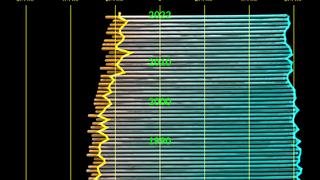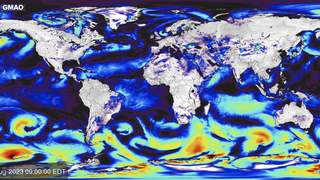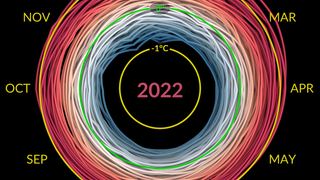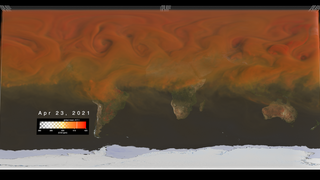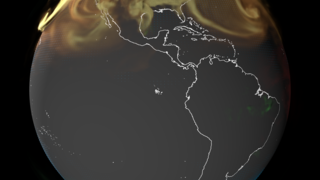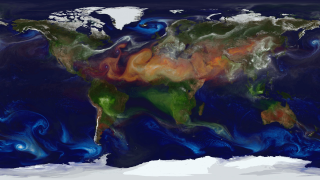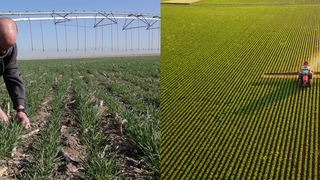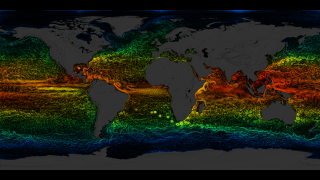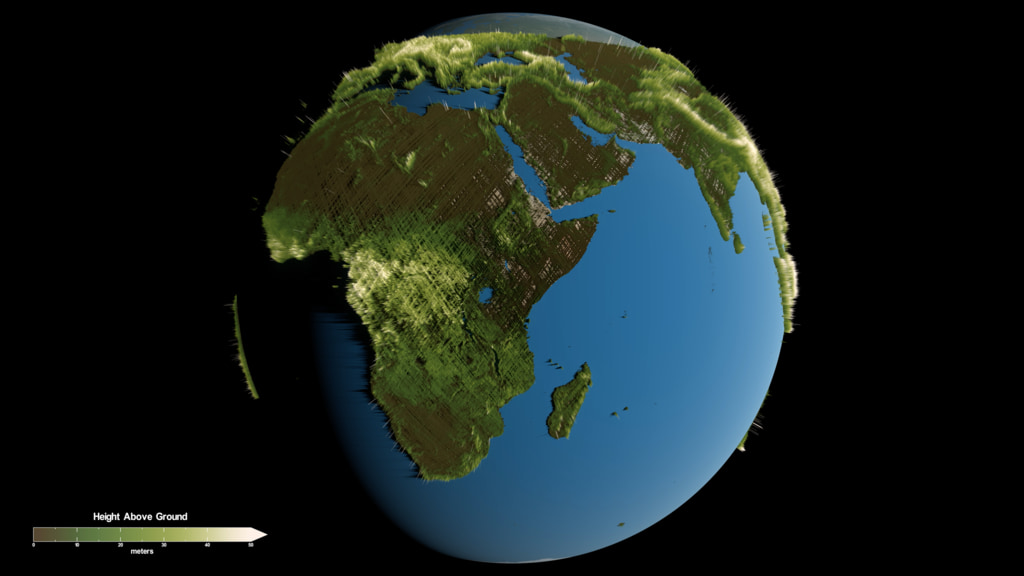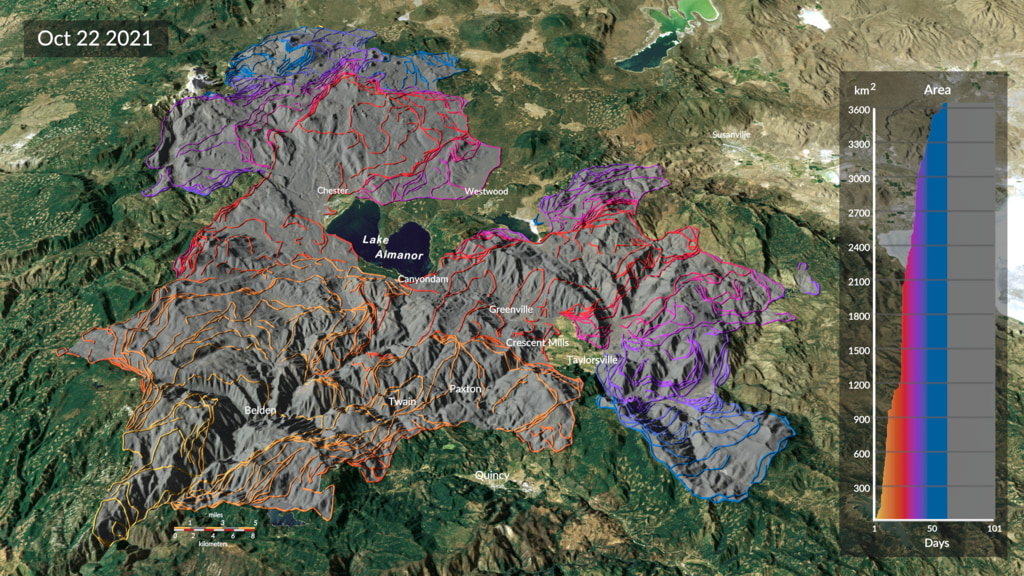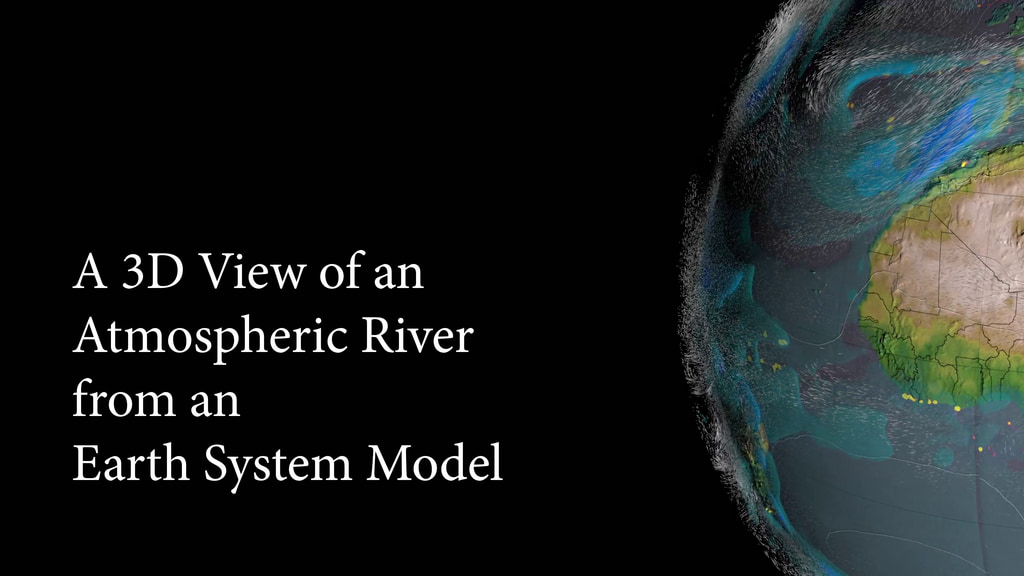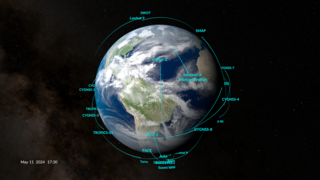Earth Information Center (EIC)
Overview
For more than 50 years, NASA satellites have provided data on Earth's land, water, air, temperature, and climate. The Earth Information Center (EIC) allows visitors to see how our planet is changing in six key areas: sea level rise and coastal impacts, health and air quality, wildfires, greenhouse gases, sustainable energy, and agriculture. This information supports decision makers in developing the tools they need to mitigate, adapt, and respond to climate change.
Drawing from insight provided by NASA centers from coast to coast, and in close coordination with other government agencies, industry partners and communities, the Earth Information Center delivers critical data directly into the hands of people in ways that they can immediately use.
Through the Earth Information Center discover how NASA sees the unseen and consider why this information matters to us all.
This gallery consists of content used in the hyperwall display in the Earth Information Center at NASA Headquarters.
EIC Dashboards
Main Dashboard
Go to this pageThis gallery consists of content used in the Main Dashboard at the hyperwall display at the Earth Information Center (EIC), NASA HQ.
Earth Now Dashboard
Go to this pageNASA satellites provide data on Earth's land, ecosystems, water, air temperature, and climate - and have done so for more than 50 years. Earth information from space supports decision makers, partners, and people in developing the tools they need to mitigate, adapth, and respond to our changing planet. The visualizations featured on this dashboard show the latest imagery available.
Climate Vital Signs Dashboard
Go to this pageNASA monitors the health of our planet to benefit human kind. Our missions track key climate indicators and we share these with the world.
Greenhouse Gases Dashboard
Go to this pageNASA and its partner agencies track greenhouse gases for space, air, and ground. our scientists model the flow of these gases around our planet.
Carbon Dioxide Sources and Sinks
Go to this pageNASA models the flow of carbon dioxide; its emission, its transport around the globe, and its absorption by the ocean and biosphere.
EIC Videos
Videos produced for NASA's Earth Information Center.
Air Quality in DC
Go to this pageNASA-supported scientist Susan Anenberg reviews air pollution data from satellites, airplanes, and ground sensors and combines it with data on race, ethnicity, poverty, and health. In doing so Anenberg unveils the both the big picture of air pollution and individual neighborhood effects. Information that lets community leaders and other decision makers to make better decisions and address long standing inequities.
NASA and Hurricanes
Go to this pageHurricanes are getting stronger due to climate change warming the air and oceans. NASA atmospheric scientist Mara Fuentes says NASA sees deep into hurricanes to better their power, track storms through the night, and precisely map flooding in real time. NASA shares this information with partners like NOAA for weather forecasts and FEME to support emergency responders. Before, during, and after a hurricane, NASA data is put to use by decision makers to make critical decisions.
NASA and Agriculture Video
Go to this pageThe farmers responsible for the food that reaches your plate need a lot of a very precious and limited resource, water. NASA works with farmers like Dwane Roth of Kansas to help them track their water use. Roth says that farmers like him are seeing more frequent, hotter days with less rain. “We need to grow more with less and get as much out of each drop of water we can,” he says. NASA helps to promote the use of Earth observations to strengthen food security. One solution is OpenET, a system that puts near-real-time water data into the hands of farmers in the United States.
EIC Beauty Pieces
Global Sea Surface Currents and Temperature
Go to this sectionThis visualization shows sea surface current flows. The flows are colored by corresponding sea surface temperature data. This visualization is rendered for display on very high resolution devices like hyperwalls or for print media.This visualization was produced using model output from the joint MIT/JPL project entitled Estimating the Circulation and Climate of the Ocean, Phase II (ECCO2). ECCO2 uses the MIT general circulation model (MITgcm) to synthesize satellite and in-situ data of the global ocean and sea-ice at resolutions that begin to resolve ocean eddies and other narrow current systems, which transport heat and carbon in the oceans. The ECCO2 model simulates ocean flows at all depths, but only surface flows are used in this visualization.
GEDI Forest Height
Go to this pageThis visualization depicts a global view of forest height data collected by the GEDI instrument aboard the International Space Station. Brown and dark green represent shorter vegetation. Bright green and white represent taller vegetation. This visualization uses data collected between April 2019 and April 2020. Height is exaggerated to depict variation at this scale.Coming soon to our YouTube channel. || GEDI_global_w_colorbar_0900_print.jpg (1024x576) [83.4 KB] || GEDI_global_w_colorbar_0900_searchweb.png (320x180) [42.8 KB] || GEDI_global_w_colorbar_0900_thm.png (80x40) [4.0 KB] || GEDI_global_w_colorbar_1080p60.mp4 (1920x1080) [17.7 MB] || GEDI_global_w_colorbar_1080p60.webm (1920x1080) [6.0 MB] || GEDI_global_w_colorbar (3840x2160) [256.0 KB] || GEDI_global_w_colorbar_2160p30.mp4 (3840x2160) [61.5 MB] || GEDI_global_w_colorbar_2160p60.mp4 (3840x2160) [65.5 MB] || captions_silent.31845.en_US.srt [43 bytes] ||
Spread of the Dixie Fire - 2021
Go to this pageThis visualization shows the spread of the Dixie fire between July 14 and October 22, 2021, updated every 12 hours based on new satellite active fire detections. The yellow outlines track the position of the active fire lines for the last 60 hours, with the latest location of the fire front in the brightest shade of yellow. The red points show the location of active fire detections, while the grey region shows the estimated total area burned. The graph shows the cumulative burned area in square kilometers.Coming soon to our YouTube channel. || Dixie_fire_2021.7135_print.jpg (1024x576) [369.5 KB] || Dixie_fire_2021.7135_searchweb.png (320x180) [139.8 KB] || Dixie_fire_2021.7135_thm.png (80x40) [8.3 KB] || Dixie_fire_2021_p30_1080p30.mp4 (1920x1080) [172.9 MB] || Dixie_fire_2021_1080p60.mp4 (1920x1080) [190.8 MB] || Dixie_fire_2021_p30_1080p30.webm (1920x1080) [12.1 MB] || Dixie_fire_2021_p30_2160p30.mp4 (3840x2160) [477.6 MB] || Dixie_fire_2021_2160p60.mp4 (3840x2160) [513.8 MB] || 3840x2160_16x9_60p (3840x2160) [512.0 KB] || captions_silent.32827.en_US.srt [43 bytes] ||
A 3D View of an Atmospheric River from an Earth System Model
Go to this pageNarrated atmospheric rivers movieComing soon to our YouTube channel. || atmos_rivers_narrated_4k.00090_print.jpg (1024x576) [88.5 KB] || atmos_rivers_narrated_4k.00090_print_searchweb.png (320x180) [46.0 KB] || atmos_rivers_narrated_HD.mp4 (1920x1080) [410.9 MB] || atmos_rivers_narrated_HD.webm (1920x1080) [68.6 MB] || atmos_rivers_narrated_4k.mp4 (3840x2160) [646.9 MB] || atmos_river_narrated_4k.en_US.srt [6.3 KB] || atmos_river_narrated_4k.en_US.vtt [6.3 KB] || atmos_rivers_4k.en_US.vtt [6.3 KB] ||
Media Resources
Earth Information Center Media B-Roll
Go to this pageThe Earth Information Center is a physical and virtual space that showcases NASA Earth information and how our partners and everyday people use Earth observations to solve our planet’s most pressing issues. It provides a view of our home planet down to local neighborhoods, from outer space. It shows how our planet is changing and provides easy-to-use information and resources we need to mitigate, adapt, and respond to climate change. The Earth Information Center at NASA’s headquarters building is a physical space that includes various parts: an Earth Pulse sculpture of lights showing NASA Earth data, a Hyperwall that showcases awe-inspiring visualizations and stories told by people using NASA Earth data, the Space for Earth immersive experience surrounding you with science, and an Eyes on Earth interactive kiosk.Images of the June 21, 2023 ribbon cutting ceremony can be found on the NASA Flickr account ||
Daily Visualizations
Daily Visualizations
Go to this pageThis gallery brings together the data visualizations that are updated daily for NASA's Earth Information Center (EIC).
